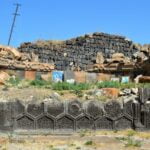Are you ready to embark on a journey through time and uncover the secrets of the enigmatic Armenian Church? Prepare to feast your mind on captivating facts that unveil the rich cultural heritage and profound religious traditions of this ancient institution. As we delve into the depths of history, guided by my expertise as an experienced religious historian and writer, we will explore the fascinating world of Armenian churches. From their architectural marvels to the hidden stories etched within their walls, this article invites you to discover the mystique and unique aspects of these sacred spaces. Get ready to embrace a captivating adventure unlike any other as we unravel the intriguing facts about the Armenian Church.

Facts About Armenian Church
Armenia, a country steeped in rich history and cultural heritage, is home to one of the oldest Christian churches in the world – the Armenian Apostolic Church. As an experienced religious historian and writer, I have had the privilege of exploring and documenting captivating facts about Armenian churches. In this article, we will delve into the fascinating world of Armenian church architecture and uncover the unique aspects that make them so enigmatic.
A Rich Legacy of Christianity
The Armenian Apostolic Church holds a special place in the hearts of the Armenian people. Being the national church, it has played a pivotal role in shaping their religious and cultural identity. It all began in the 4th century, when Armenia became the first country to adopt Christianity as its state religion, thanks to the efforts of St. Gregory the Illuminator who converted the Armenian king in 300 CE. The establishment of the Armenian Apostolic Church marked the beginning of a new era for the Armenian people, and their devotion to their faith is truly awe-inspiring.
Quote: “The Armenian Apostolic Church holds a rich legacy as the first nationally recognized Christian church, tracing its origins back to the 4th century.”
Unveiling the Architectural Marvels
One cannot talk about Armenian churches without marveling at their architectural beauty. The early Armenian churches, built between the 4th and 7th century, predominantly followed the basilica style, characterized by a rectangular shape and a central nave. However, these churches were not mere replicas of each other. Each carried its unique charm and architectural features. Some churches even incorporated side apses, adding a touch of elegance to the structure.
Quote: “Armenian churches, though sharing the basic basilica style, captured the imaginations of architects and worshippers alike with their unique architectural elements and individualistic designs.”
The Rise of the Cupola
By the 5th century, a significant change occurred in Armenian church architecture. The introduction of the cupola, a dome-like structure, became widely popular. This architectural innovation not only added grandeur to the churches but also enhanced their structural integrity. The cupola gave Armenian churches their distinctive silhouette, with a cone-shaped roof rising from the center. It symbolized a spiritual connection between heaven and earth, and its presence became synonymous with Armenian churches.
Quote: “The cupola, with its majestic presence atop Armenian churches, became a visual representation of the sacred bond between the divine and the earthly realms.”
Unraveling Hidden Secrets
Armenian churches are not only architectural wonders but also treasure troves of hidden secrets. The interiors of these churches are adorned with intricately carved stone reliefs, frescoes, and stunning mosaics that depict religious scenes and stories. Each artwork holds a deeper meaning, inviting visitors to contemplate and connect with the divine. These hidden secrets within Armenian churches offer a glimpse into the spiritual world and reflect the unwavering devotion of the Armenian people.
Quote: “Step inside an Armenian church, and you will be transported into a realm of hidden secrets, where stone reliefs, frescoes, and mosaics come alive with stories and spiritual wonders.”
Preserving a Heritage
Preserving Armenian churches and their cultural significance is of utmost importance. These architectural gems hold immense historical value and offer insights into the rich tapestry of Armenian religious traditions. Efforts are being made to restore and conserve these churches, ensuring that future generations can explore and appreciate their magnificence. By embracing the facts about Armenian churches, we can contribute to the preservation and celebration of this unique cultural heritage.
Quote: “By recognizing and appreciating the facts about Armenian churches, we become advocates for their preservation, protecting a heritage that holds significant historical and cultural value.”
In conclusion, the Armenian churches are an enchanting fusion of faith and architectural brilliance. From their humble beginnings as simple basilicas to the introduction of the mesmerizing cupola, each church tells a story of resilience, devotion, and artistic ingenuity. By unraveling these captivating facts, we not only gain a deeper understanding of Armenian religious traditions but also celebrate the enduring legacy of the Armenian Apostolic Church.
Quote: “Armenian churches stand as a testament to the enduring faith and artistic brilliance of the Armenian people, inviting us to unravel their captivating facts and embrace their enigmatic beauty.”
Armenia, a small country nestled in the stunning landscapes of the South Caucasus region, holds a treasure trove of fascinating facts waiting to be uncovered. From its ancient history, preserved in awe-inspiring archaeological sites like the medieval Tatev Monastery, to its vibrant culture celebrated through traditional dances like the Kochari, Armenia will captivate and mesmerize you at every turn. Immerse yourself in the enchanting beauty of Lake Sevan, known as the “Blue Pearl of Armenia,” or explore the hidden mysteries of the ancient cave city, Khndzoresk. If you’re yearning for an adventure that unveils the richness of a country steeped in both tradition and progress, delve into the captivating world of Armenia and uncover its many wonders. Discover more about the captivating facts about Armenia here.
The Armenian Church is a rich and fascinating institution, and there are endless captivating facts waiting to be discovered. Are you ready to uncover some of the most interesting details about this ancient church? Get ready to be amazed! Whether you’re interested in its historical significance, architectural marvels, or cultural traditions, there’s something for everyone. Dive into the intriguing world of the Armenian Church and learn about its captivating history and legacy. Discover the interesting facts about the Armenian Church by clicking here. Prepare to be fascinated by the hidden stories and extraordinary wonders that await you. If you’re seeking even more enchantment, be sure to explore the fascinating facts about the Armenian Church that will leave you in awe. From mesmerizing artwork to sacred traditions, you’ll be captivated by every detail. But wait, there’s more! Brace yourself for the most amazing facts about the Armenian Church that will push the boundaries of your imagination. Click here to uncover the mysteries and marvels that make this ancient institution truly extraordinary. Get ready for a journey like no other, where history and culture intertwine in the realm of the Armenian Church.
FAQ
Question 1
What is the national church of the Armenian people?
Answer 1
The national church of the Armenian people is the Armenian Apostolic Church.
Question 2
When did Armenia adopt Christianity?
Answer 2
Armenia was the first country to adopt Christianity, with St. Gregory the Illuminator converting the king in 300 CE.
Question 3
When were the first Armenian churches built?
Answer 3
The first Armenian churches were built between the 4th and 7th century when Armenia converted to Christianity.
Question 4
What was the architectural style of the early Armenian churches?
Answer 4
The early Armenian churches were mostly simple basilicas, but some had side apses.
Question 5
What architectural feature became widely used in Armenian church architecture by the 5th century?
Answer 5
By the 5th century, the typical cupola cone in the center became widely used in Armenian church architecture.
- Uncovering Surprising Parallels: England Size Compared to US States - April 19, 2025
- Old Mexico Map: Border Shifts 1821-1857 - April 19, 2025
- Blindness Doesn’t Limit: Popular Blind People’s Inspiring Success Stories - April 19, 2025
















